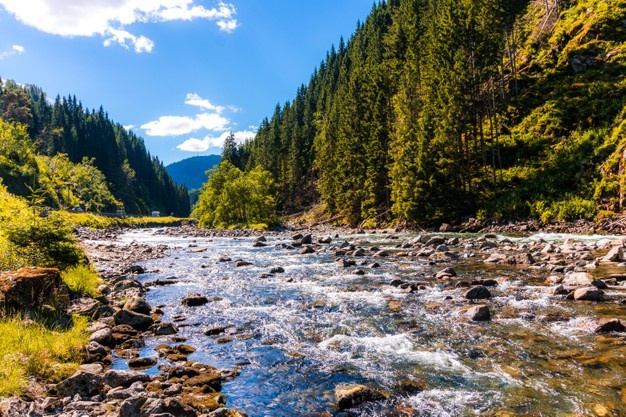The Himalayas and Ganga in their varied display of nature’s glory personify the medley of inner calmness and outer activity, which are essential qualities for every spiritual aspirant. For centuries, they have been revered and associated with religious sentiments.
However, for the worshippers of divinity in nature, these ancient mountains and rivers carry deeper symbolism. For instance, in the presence of the Himalayas, many discover an ineffable peace that then flows over into one’s daily activities like the Ganges river flowing from the high plains to reach the masses. Exploring such symbolism of the Himalayas and Ganga can be a worthy exercise regardless of where one dwells, and this is the purpose of this work.
Just like the thousands of nature zealots who are drawn to the Himalayas, my romance with these seemingly inert mountains began over a couple of decades ago, bringing me back repeatedly to live among its different regions.
I sought among them the ‘sacred home,’ the pristine joy of being in nature, and an unbounded inspiration for my spiritual practices. Spiritual Symbolism of the Himalayas and Ganga
One such place that has been my home in the past couple of years is the “Land of Gods”. Dev-Bhoomi (translated as ‘land of Gods & Goddesses’) is the colloquial name for this region of Garhwal Himalayas in the Uttarakhand state of India. What is special about dev-Bhoomi? Going by its literal meaning, dev-Bhoomi is where God and Goddess dwell.
Even if you don’t believe such a claim literally, it’s easy to see that such an environment is highly conducive for training one’s mind. Dev-Bhoomi is also so named due to the many pilgrimage sites spread out mostly across Uttarakhand and the Himachal region against the backdrop of the majestic Himalayas.
Some opine that this land is named dev-Bhoomi because here one finds not only the splendor of the Himalayas but also the origins of various streams that make up two of the Indian most sacred rivers—Ganga and Yamuna. Of the northern Char-dhams (four sacred sites of pilgrimage), pilgrims consider taking a dip at Gangotri to be the most purifying location based on the belief that a dip in Ganga purges one of all negative past karmas.
Thus this metaphysical meeting of father and daughter attracts thousands of spiritual seekers and Hindu pilgrims, who have traveled here from time immemorial, and further sanctified this region by their reverence. While there are many natural wonders around the world, what makes these unique is this sense of devotion among people.
Guru-principle
For an earnest spiritual practitioner, guidance can come in many ways. For an introspective and insightful mind, Life and all of one’s experiences can itself unfold the path to perfection. The Guru (divine teacher or literally, the dispeller of darkness) is not just one who comes in a physical form but that the Guru-principle (source of wisdom and divine guidance) can manifest through form and formless, living and non-living, conscious and inanimate, etc.
Accessing this Guru-principle within is to discover a mental state wherein the highest wisdom flows through without much inner and outer resistance. Yet the outer environment can help cultivate the inner environment of our thoughts and feelings.
Thus the Himalayas and Ganga, representing the Guru-principle in nature’s sublime manifestations, are potent with divine blessings and offer profound guidance on one’s path to awakening.
Many great Indian saints have lived and wandered among these sacred mountains, including Tapovan Maharaj and Swami Rama Tirtha. Their lives stand testimony to the fact that through outer pointers in nature, one can stabilize the mind in the divine state and realize the supreme reality.
These mountains have also been the source of inspiration for much of Tibetan Buddhism, ranging from Marpa and Milarepa to the current Dalai Lama (who resides in Himachal Pradesh). Tibetans continue to find terma, hidden teachings, among these mountains by enlightened teachers of the past.
Key pointers for Spiritual seekers
In this dev-Bhoomi in particular, the movement of Ganga against the backdrop of The Himalayas provides a conducive environment for contemplation and meditation. Symbolically, in the path of a spiritual seeker, he or she is initially drawn to the quietude that these mountains exude. Renouncing the outer engagements of the world, the seeker finds a new ‘home’ in the solitude of the mountains.
But as his practice matures, he finds in the vicissitude of his life the steady flow and current of divine presence or the awareness of one’s Self. Then quietness and activity no longer oppose each other within one’s mental poise.
That what strikes us the most in these lands is the energy bursting forth, and the continuous flow of Ganga against the immobile and the deeply grounded Himalayas. Whether it is the rushing waters over chiseled rocks, the rows of pine and deodar trees over steep mountain tracks, or the ebb and flow of pilgrims, this sacred land offers boundless insight and inspiration for anyone who is reflective and on the quest for inner
perfection.
In fact, as we shall explore in the following sections, it is Ganga’s restless energy and roaring sound that makes the stillness and quietness of the Himalayas even more meaningful. This interaction between the two is symbolically expressed in various spiritual traditions as the dance of spirit and nature in creation—Purusha and Prakriti, Shiva and
Shakti, Ying and Yang, and so on.
By : Swami Nirgunananda Giri
This is my full article on Dev-Bhoomi (Ganga & Himalayas) and its deeper symbolism.


